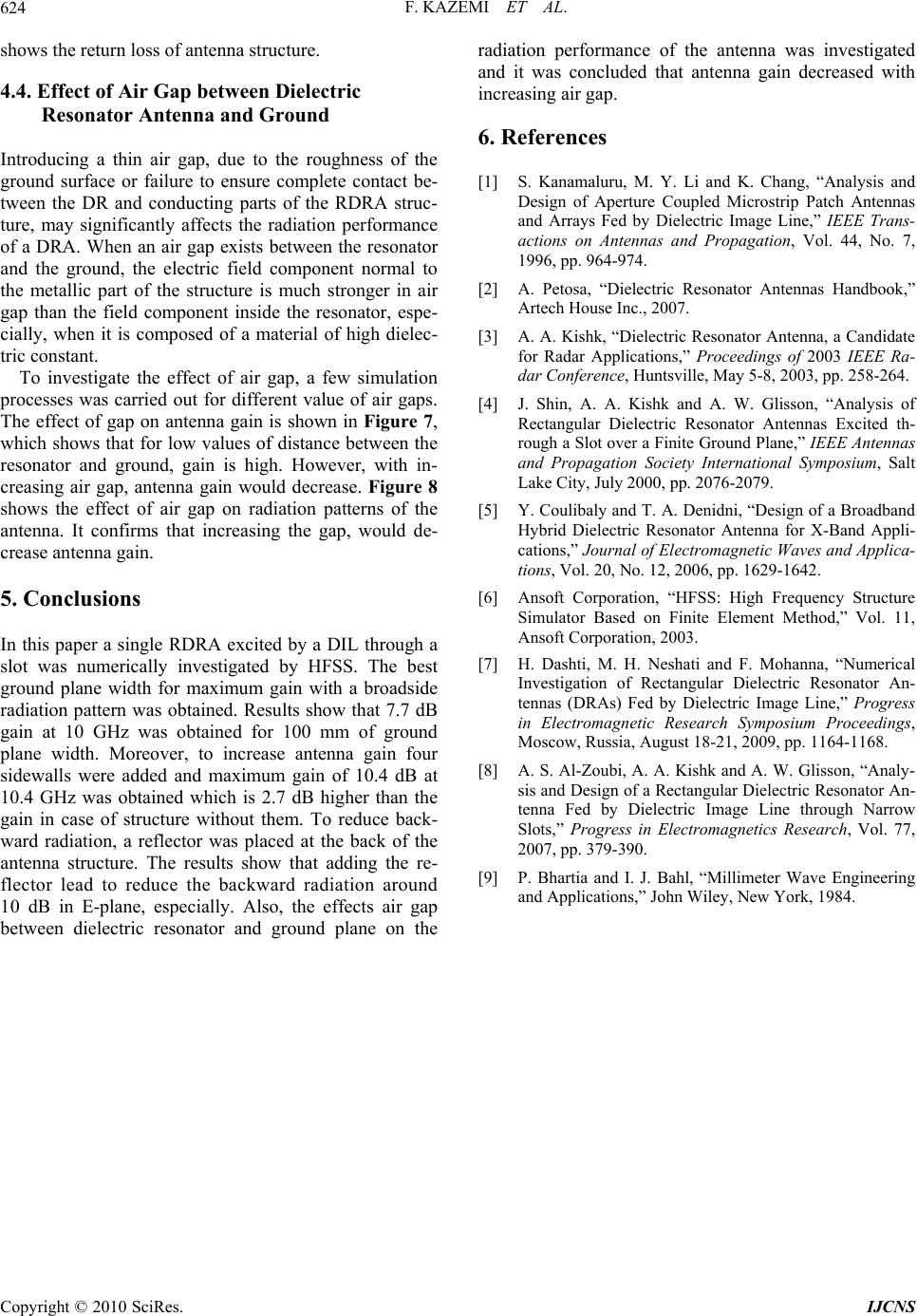
F. KAZEMI ET AL.
Copyright © 2010 SciRes. IJCNS
624
shows the return loss of antenna structure.
4.4. Effect of Air Gap between Dielectric
Resonator Antenna and Ground
Introducing a thin air gap, due to the roughness of the
ground surface or failure to ensure complete contact be-
tween the DR and conducting parts of the RDRA struc-
ture, may significantly affects the radiation performance
of a DRA. When an air gap exists between the resonator
and the ground, the electric field component normal to
the metallic part of the structure is much stronger in air
gap than the field component inside the resonator, espe-
cially, when it is composed of a material of high dielec-
tric constant.
To investigate the effect of air gap, a few simulation
processes was carried out for different value of air gaps.
The effect of gap on antenna gain is shown in Figure 7,
which shows that for low values of distance between the
resonator and ground, gain is high. However, with in-
creasing air gap, antenna gain would decrease. Figure 8
shows the effect of air gap on radiation patterns of the
antenna. It confirms that increasing the gap, would de-
crease antenna gain.
5. Conclusions
In this paper a single RDRA excited by a DIL through a
slot was numerically investigated by HFSS. The best
ground plane width for maximum gain with a broadside
radiation pattern was obtained. Results show that 7.7 dB
gain at 10 GHz was obtained for 100 mm of ground
plane width. Moreover, to increase antenna gain four
sidewalls were added and maximum gain of 10.4 dB at
10.4 GHz was obtained which is 2.7 dB higher than the
gain in case of structure without them. To reduce back-
ward radiation, a reflector was placed at the back of the
antenna structure. The results show that adding the re-
flector lead to reduce the backward radiation around
10 dB in E-plane, especially. Also, the effects air gap
between dielectric resonator and ground plane on the
radiation performance of the antenna was investigated
and it was concluded that antenna gain decreased with
increasing air gap.
6
. References
[1] S. Kanamaluru, M. Y. Li and K. Chang, “Analysis and
Design of Aperture Coupled Microstrip Patch Antennas
and Arrays Fed by Dielectric Image Line,” IEEE Trans-
actions on Antennas and Propagation, Vol. 44, No. 7,
1996, pp. 964-974.
[2] A. Petosa, “Dielectric Resonator Antennas Handbook,”
Artech House Inc., 2007.
[3] A. A. Kishk, “Dielectric Resonator Antenna, a Candidate
for Radar Applications,” Proceedings of 2003 IEEE Ra-
dar Conference, Huntsville, May 5-8, 2003, pp. 258-264.
[4] J. Shin, A. A. Kishk and A. W. Glisson, “Analysis of
Rectangular Dielectric Resonator Antennas Excited th-
rough a Slot over a Finite Ground Plane,” IEEE Antennas
and Propagation Society International Symposium, Salt
Lake City, July 2000, pp. 2076-2079.
[5] Y. Coulibaly and T. A. Denidni, “Design of a Broadband
Hybrid Dielectric Resonator Antenna for X-Band Appli-
cations,” Journal of Electromagnetic Waves and Applica-
tions, Vol. 20, No. 12, 2006, pp. 1629-1642.
[6] Ansoft Corporation, “HFSS: High Frequency Structure
Simulator Based on Finite Element Method,” Vol. 11,
Ansoft Corporation, 2003.
[7] H. Dashti, M. H. Neshati and F. Mohanna, “Numerical
Investigation of Rectangular Dielectric Resonator An-
tennas (DRAs) Fed by Dielectric Image Line,” Progress
in Electromagnetic Research Symposium Proceedings,
Moscow, Russia, August 18-21, 2009, pp. 1164-1168.
[8] A. S. Al-Zoubi, A. A. Kishk and A. W. Glisson, “Analy-
sis and Design of a Rectangular Dielectric Resonator An-
tenna Fed by Dielectric Image Line through Narrow
Slots,” Progress in Electromagnetics Research, Vol. 77,
2007, pp. 379-390.
[9] P. Bhartia and I. J. Bahl, “Millimeter Wave Engineering
and Applications,” John Wiley, New York, 1984.